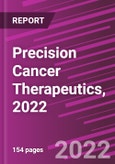Despite advances in cancer treatment, cancer continues to affect about 18.1 million people annually, generating a significant loss of life, financial burden and overall strain on the health industry. Worldwide between 35 and 40 million people are living with cancer and nearly 10 million people lose the battle annually. The most common cancers affecting the world population include lung, breast, colon/rectum, stomach, liver, prostate, cervical, esophageal, and bladder. Cancer deaths occur in about 50% of people who develop cancer in developed countries; this is in contrast to 80% death rate in cancer patients in underdeveloped countries.
Precision treatments are less invasive and less damaging to the body, and they promise improved outcomes in many cases.
The demand for more effective and tolerable cancer treatments has led to the development of novel therapeutic agents that specifically target malignant cells. Today, advanced precision cancer therapies are available, and more are being developed each year. Although there are some older precision therapies on the market, the industry is now expanding the use of these treatments to better treat cancer victims. Precision treatments are less invasive and less damaging to the body, and they promise improved outcomes in many cases.
This report Precision Cancer Therapeutics, 2022 specifically focuses on five leading segments of precision therapies:
- Monoclonal antibodies
- Kinase inhibitors
- Angiogenesis inhibitors
- Proteasome inhibitors
- CAR-T therapies
- Other precision therapies
Additionally, smaller areas of precision therapies are covered including mTOR inhibitors, PI3K inhibitors, PARP inhibitors, apoptosis inhibitors, histone deacetylase inhibitors, CDK inhibitors, hedgehog signaling pathway inhibitors and several others.
Scope and Methodology
The analyst has watched the cancer treatment market evolve over the past two decades and evaluated the impact new technologies are making on the market. Precision Cancer Therapeutics, 2022 focuses on the expanding area of precision cancer therapies and includes current products available and discusses some of the most exciting developments in progress.
This report covers precision cancer therapies that do at least one of the following:
- Block or turn off chemical signals that tell the cancer cell to grow and divide
- Change proteins within the cancer cells so the cells die
- Stop making new blood vessels to feed the cancer cells
- Trigger the immune system to kill the cancer cells
- Carry toxins to the cancer cells to kill them, but not normal cells
The report includes statistical information for cancers by type on a global level. Specifically, cancers where there are current products available or are in development and/or have significant incidence/mortality rates are profiled. The market segments provide an overview of disease epidemiology, leading product sales, market estimates and forecasts, and competitive summary of leading providers. The report also includes a list of Phase 3 precision therapies in development. Throughout the report, several market indicators, trends and barriers are discussed.
The following are companies of focus in the report:
- AbbVie
- Astellas Pharma U.S., Inc
- AstraZeneca PLC
- Bayer AG
- Bristol-Myers Squibb Company
- Clovis Oncology, Inc.
- Dendreon Pharmaceuticals LLC
- Eli Lilly & Company
- EMD Serono, Inc. (Merck KgaA)
- Eisai Co., Ltd.
- Exelixis, Inc.
- Gilead Sciences, Inc.
- GlaxoSmithKline
- Johnson & Johnson
- Merck & Co., Inc.
- Novartis AG
- Otsuka Holdings Co., Ltd.
- Pfizer, Inc.
- Puma Biotechnology, Inc.
- Roche (F. Hoffman-La Roche, Ltd.)
- Sanofi/Genzyme
- Seagen Inc.
- Takeda
Table of Contents
Chapter 8: Precision Cancer Therapies: Other Precision Therapies
Companies Mentioned
- AbbVie
- Astellas Pharma U.S., Inc
- AstraZeneca PLC
- Bayer AG
- Bristol-Myers Squibb Company
- Clovis Oncology, Inc.
- Dendreon Pharmaceuticals LLC
- Eli Lilly & Company
- EMD Serono, Inc. (Merck KgaA)
- Eisai Co., Ltd.
- Exelixis, Inc.
- Gilead Sciences, Inc.
- GlaxoSmithKline
- Johnson & Johnson
- Merck & Co., Inc.
- Novartis AG
- Otsuka Holdings Co., Ltd.
- Pfizer, Inc.
- Puma Biotechnology, Inc.
- Roche (F. Hoffman-La Roche, Ltd.)
- Sanofi/Genzyme
- Seagen Inc.
- Takeda








